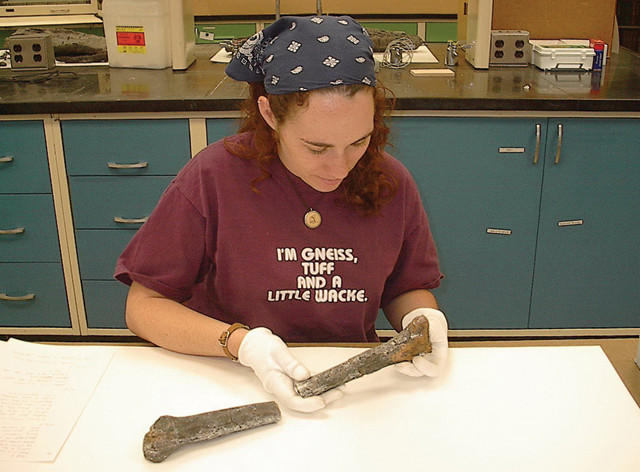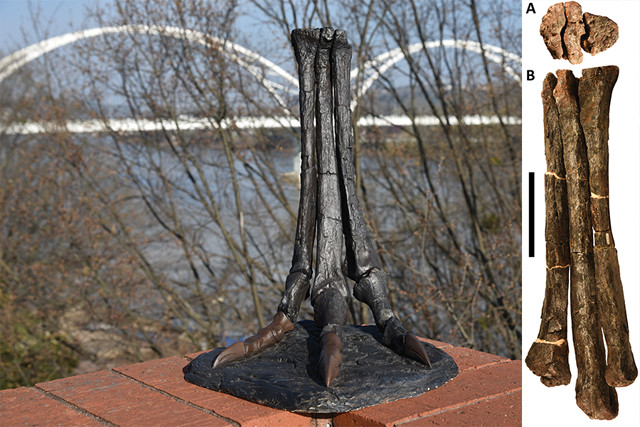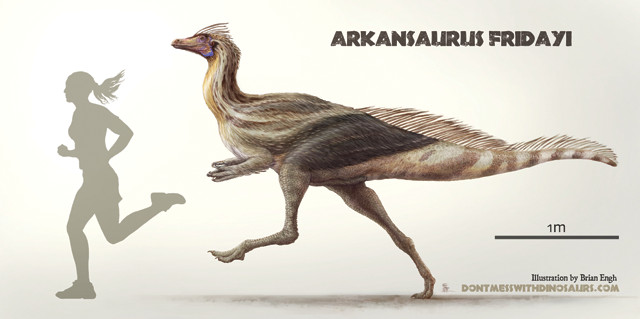
by David Moscato Tuesday, January 15, 2019
In 1972, the first dinosaur remains ever found in Arkansas — a fossilized foot — were pulled out of a gravel and sand pit near the Sevier County town of Lockesburg in the southwestern part of the state. Though the foot remained a scientific mystery for decades, it became something of a local celebrity. In February 2017, with help from an enthusiastic high school student, the species from which the fossil originated was designated the state dinosaur of Arkansas. And about a year later, in March 2018 — more than 45 years after its initial discovery — the dinosaur finally received a thorough scientific description and an official scientific name: Arkansaurus fridayi.
The first human to see Arkansaurus was a man named Joe B. Friday. In 1972, at the edge of his land, a pit recently excavated to provide gravel and sand for nearby road construction exposed a deposit of grayish clay. Nestled in the clay, Friday spotted a collection of bones that would turn out to be the first dinosaur fossil discovered in Arkansas.
Friday didn’t know at first that he had discovered a dinosaur, nor that the clay layer that held the bones, part of the Trinity Group, dated to the Early Cretaceous, more than 100 million years ago. It wasn’t until, after some months of sharing the ancient curiosity with customers of the service station he owned, a friend’s son, who was a student at the University of Arkansas, asked if he could show the bones to one of his professors. The student, Doy Zachry, took the bones to Fayetteville and showed them to paleontologist James Quinn.
Quinn identified the remains as the right foot of a dinosaur belonging to the ornithomimid family, the group that includes the famous two-legged, fast-running Ornithomimus, whose name means “bird mimic.” In 1973, he presented the discovery at the south-central section meeting of the Geological Society of America in Little Rock. By that time, he had begun referring to it by a nickname, “Arkansaurus fridayi,” in honor of the state and the man who found it. (Published scientific names are conventionally written in italics, while unpublished or unofficial names are enclosed in quotation marks.)
Friday ultimately donated the foot to the University of Arkansas, but although he, Quinn and others found a few more foot bones in their continued fossil hunting at the quarry, no other part of the dinosaur’s body was ever found. Many questions remained: Was this a new species of dinosaur? Where did it fit into the story of North American dinosaur evolution? With only a foot, it would be difficult to answer these questions. And without a thorough description, Quinn wouldn’t be able to give the fossil an official name.
Before he had a chance to finish his research on the dinosaur, however, Quinn died in a fall while fossil hunting at a quarry in Nebraska in 1977. It would be decades before another scientist took up the task of investigating “Arkansaurus.”
Some states, such as Colorado, Montana and New Mexico, have an abundance of dinosaur fossils. Arkansas is not one of these states.
n Arkansas, most of the rocks of the right age to preserve dinosaur-dominated ecosystems have either long since eroded away or are covered in fossil-shredding vegetation, so dinosaur-bearing sediments are limited to a small number of creek beds and similar exposures. Dinosaur bone fragments and footprints are known from some rocks of the Trinity Group, but to this day, the lone foot found near Lockesburg is the most significant dinosaur fossil discovered in the state.

ReBecca Hunt-Foster, the paleontologist who described and officially named Arkansaurus fridayi, is seen studying the fossilized foot bones in 2003. Credit: courtesy of ReBecca Hunt-Foster.
In 2002, the fossil was first examined by the scientist who would come to know it best. ReBecca Hunt-Foster, now the park paleontologist at Dinosaur National Monument in Utah, was then an undergraduate geology student working in the campus museum at the University of Arkansas, where Doy Zachry had become a professor. Hunt-Foster had seen the foot on display there, but it wasn’t until a 2002 conversation with fellow paleontologist Jim Kirkland that she learned that “Arkansaurus fridayi” had never been properly scientifically described.
Hunt-Foster set out to describe and identify the foot, but faced a challenge: Ornithomimid specimens are rare, especially from the Early Cretaceous of North America. Perhaps these dinosaurs didn’t congregate in the kinds of environments that best promote later fossilization, or perhaps they just haven’t been favored in the often-random lottery that is the fossil record. In any case, to identify a new species or confirm a fossil’s place on an evolutionary family tree, researchers need other fossils for reference.
“At that time, there just wasn’t a whole lot to compare it to,” Hunt-Foster says. “In 2003, the ornithomimid literature was pretty slim, especially for Early Cretaceous material.” She published a small report for an undergraduate research conference, agreeing with Quinn that the foot represented some variety of the ostrich-like ornithomimids and that it was among the oldest of its kind in North America. Most other such dinosaurs are from the Late Cretaceous. She left it at that, and “walked away from it for a while,” she says.
The dinosaur foot may have been a scientific puzzle but was still the best-known dinosaur from Arkansas, so it had become a bit of a local celebrity. It was mentioned in pamphlets by the Arkansas Geological Survey, and the survey’s learning center even created an imagined full-body reconstruction (based mainly on the appearance of other ornithomimids). And as so many fossils do, it caught the attention of children.
One child from Fayetteville, Mason Cypress Oury, noticed that among the state symbols of Arkansas — the state flower (apple blossom), state insect (honeybee), state rock (bauxite) and so on — there was no state dinosaur. Other states had them, so why not Arkansas? For years, Oury contacted local politicians to lobby for their support and draw attention to his cause in the media. In a 2016 interview with Inverse, he argued: “It’s the only dinosaur unique to Arkansas. It’s the only dinosaur that truly bleeds Razorback Red.”
In January 2017, Oury, by then a high school senior, sat before a panel at the state house alongside state Rep. Greg Leding and proposed that there was no better pick for the Arkansas State Dinosaur than the first dinosaur fossil discovered in the state.
On Feb. 17, 2017, a bill introduced by Leding, HCR1003, was approved by Gov. Asa Hutchinson, and “Arkansaurus fridayi” became the official state dinosaur, “since it is unique to the State of Arkansas, brings recognition to the State of Arkansas, and promotes an interest in paleontology in Arkansas.”
Coincidentally, while this legislative task was underway, the fossil foot had actually been removed from the University of Arkansas museum. Another scientific study had begun.

Arkansaurus fridayi's fossil foot was discovered in 1972 by Joe B. Friday on his land near Lockesburg, Ark. Credit: both: courtesy of ReBecca Hunt-Foster.
In 2016, Hunt-Foster was district paleontologist for the Bureau of Land Management in Utah. She had spent several years working on a variety of dinosaur fossils but hadn’t thought much about ornithomimids since 2003. Sitting at a trailhead, reading over the latest dinosaur science, she came across a new study about Ornithomimus and was surprised and excited to learn that there had been a great deal of research on ornithomimids over the past decade or so, including many new discoveries. With all this new information, it was time to revisit that old foot from Arkansas.
She borrowed the fossil from the University of Arkansas museum for the study. This time, she had many other ornithomimids with which to compare it: Harpymimus from Mongolia, Beishanlong from China, Kinnareemimus from Thailand, Nedcolbertia from Utah and more.

Arkansaurus, which means "Arkansas' Reptile," was an ancestral relative of North American Late Cretaceous ornithomimids like Ornithomimus and Struthiomimus. Credit: illustration by paleoartist Brian Engh/courtesy of ReBecca Hunt-Foster.
Hunt-Foster was able to show that “Arkansaurus” represented an early branch of the ornithomimid family tree, retaining some more ancient features of the foot than its Asian cousins, and thus was an important piece of the puzzle of the early evolution and global spread of this dinosaur family. She also identified several features of the foot that were distinct enough from all other ornithomimids to confirm what James Quinn had suspected — this was indeed a new species of dinosaur.
Every new species needs an official name, and Hunt-Foster decided to stick with the name Quinn had conceived. “I respect the work that he did and wanted to include as much of his presence in this project as I could,” she says. “I fully believe that he probably would have published on it at some point.”
It was also during this time that she heard of the push to name the Arkansas state dinosaur after this fossil. She contacted Oury and Leding to let them know of her work and to help them include scientific information in their bill.
On March 19, 2018, her study was published online in the Journal of Vertebrate Paleontology. The paper had two authors: Hunt-Foster and, posthumously, James Quinn. One year after its designation as the state dinosaur of Arkansas and more than 45 years after it was pulled from a gravel pit by Joe Friday, the foot became, officially, Arkansaurus fridayi.
© 2008-2021. All rights reserved. Any copying, redistribution or retransmission of any of the contents of this service without the expressed written permission of the American Geosciences Institute is expressly prohibited. Click here for all copyright requests.